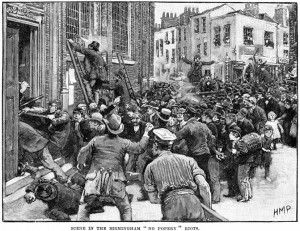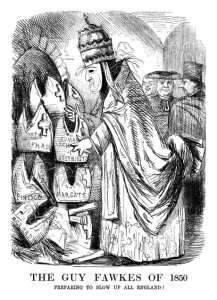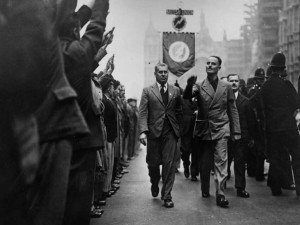William Murphy and Orangeism in mid-Victorian England
Published in 18th–19th - Century History, Features, Issue 2 (March/April 2016), Volume 24THE PHENOMENON OF ANTI-PAPAL PUBLIC ORATION IN BRITAIN
By Daniel Downer

Scene of a ‘no popery’ riot in Birmingham in 1868, provoked by the preaching of William Murphy. (Alamy)
Perhaps William Murphy represents the best example of attempts by preachers to combine an appeal to native conservative opinion with an Orange tribalism. Murphy stands as the most notorious of all the Victorian Protestant orators, combining a vocal campaign against the wrongs of the Roman Church with appeals to native concern over the problematic issues of Fenianism and increased Irish migration to Britain. Murphy’s beginnings appear somewhat unconventional when one considers his impact on the pages of British history. He was born and baptised a Roman Catholic in County Limerick in 1834; his father subsequently converted to the reformed faith and became a preacher. Murphy would later claim that he witnessed the murder of his father at the hands of a Catholic mob, forcing him to flee to Liverpool in 1862 and become an evangelist preacher.
Sectarian atmosphere of Victorian Liverpool
Murphy was influenced by the sectarian atmosphere of Victorian Liverpool, equating his evangelical message with a need to identify with and belong to the ‘Orange tribe’. Examination of his public repertoire reveals a calculated appeal not only to receptive Lancashire Orangemen but also to the general native population. A typical example is his Confessional unmasked, which played on the public obsession with the alleged pornographic brutality of Catholic convents. Murphy’s touring stage show quickly found a receptive audience among the working-class population, who had watched the increasing flood of starving Irish migrants and the transplantation of their alien faith for decades with a mixture of apprehension and curiosity.
Throughout the 1850s and 1860s, Murphy also skilfully combined a xenophobic concern about Irish political issues with a conservative apprehension regarding the increasing revival and power of the English Catholic Church. In doing so he differed from Gavazzi and De Camin, publicly equating the terms ‘Irish’ and ‘Catholic’ and ensuring that it was Ireland rather than Italy that served as the ideological battleground against papal expansion. If Ireland—and the streets of British cities that swarmed with Irish Catholics—was the battleground of the papal advance, then Murphy naturally considered that Orangemen were the defenders of the Protestant way of life.
Murphy’s combination of Irish political issues with social issues such as temperance allowed him to broaden his appeal to both Orangemen and conservatives. He quickly acquired a somewhat Paisley-like public aura and persona, and, as MacRaild has noted, ‘to his Protestant admirers Murphy became a public hero, a messenger of truth, defender of the faith and an established performer’. It was unsurprising, therefore, that Murphy would become the darling of the Orange Order, becoming publicly associated with, welcomed by and championed by the institution at every given opportunity. To the working-class British Orangeman, Murphy provided a degree of articulation to the public demonstrations and disturbances that had been associated with Orangeism. Through his association with the Order and the Irish political question, Murphy ceased to be merely an evangelical Protestant preacher in the north of England and resembled more a figure such as Oswald Mosley and his British Union of Fascists in 1930s London. His deliberate attempts to transplant a violent Ulster Protestant tribalism to Britain during the 1860s would lead to public outbreaks of violence and disorder.
Focus on Fenianism
Murphy saw the increased public fear and hatred of the Irish aroused by the emergence of Fenianism as a brilliant opportunity. An Irish nationality and Catholic faith shared by the majority of Fenians (in spite of their avowed anti-clericalism) was trumpeted by Murphy as public confirmation of the aggressive Catholic, Irish expansion and stereotype that he had warned against for the best part of a decade. Focus on Fenianism allowed Murphy to put an articulate and justified face on the claims and doctrines of Orangeism, holding the institution up to the British public as the body that had held the frontier of the British way of life against the brutal Catholic hoard in Ireland for decades. Murphy regularly claimed that Orangeism had foretold and warned the British people of the magnitude of the threat posed by the twin evils of Catholicism and Irish nationalism, but it had been shamefully rejected and scorned by a political establishment who wished to remain ‘respectable’ and aristocratically aloof at all times.
Violence followed Murphy wherever he went. Having observed Bradford after a Murphy riot in 1869, Timothy Healy years later recalled: ‘On a small scale it resembled the devastated regions of France in 1918’. In a similar fashion to Mosley half a entury later, violence presented Murphy with both an opportunity and a handicap, allowing him to exploit the British commitment to freedom of speech in the face of oppositional violence yet at the same time earning him the disdain and revulsion of the ‘respectable’ native population. Native attitudes towards Murphy can be seen in the disdainful rejection and reporting of his events by the local and national press at Ashton in 1868. The Illustrated Police News noted how Murphy’s lectures provided little more than a mask for an outbreak of local xenophobic rioting and disorder:
‘Mr Murphy has been delivering his so-called “lecture” at Ashton-under-Lyme with the usual result—rioting. On Friday night a large crowd gathered in the streets and proceeded to “Little-Ireland”, where they proceeded to smash windows. The people were armed with formidable weapons and their demeanour was so threatening that the mayor called out the volunteers to assist the police. On Sunday, Mr Murphy “preached” in the afternoon and evening. A notice to quit has been served upon him but he ridicules all attempts to drive him away.’

Punch magazine’s response to the re-establishment of the Catholic hierarchy in England in 1850. Murphy skilfully combined a xenophobic concern about Irish political issues with a conservative apprehension regarding the increasing revival and power of the English Catholic Church.
‘Regarding the advent of Murphy and his colleagues as ill-timed and likely to cause disorder, the authorities of the town have from its commencement not looked upon this event in a friendly manner. The authorities had put Murphy to some expense and now he sought his turn to trouble the authorities, and his past experience taught him how best this should be done. An Orange procession was the device adopted; this was to be the day of triumph or of death and everything was done to embitter and insult the Catholic population of the town that could be done. By and by came banners and odd insignia belonging to local Orange lodges, several swords and maces were in evidence, and every now and then the report of pistols on display gave evidence that weapons not classed as “regalia” were common. Loud cheering greeted the arrival of the Prince William fife and drum band; following the instructions of Mr Murphy, the band struck up “croppies lie down”, a procession was immediately taken up and Murphy took to firing his revolver in the air. A determined attempt was made to divert the procession into an area where a great many Irish reside. Murphy publicly declared that the purpose of the procession was simply and solely to justify their right to freedom of speech, and no magistrate of popish party could ever take away this right.’
‘Political martyr cult’
Despite appeals by the authorities to local Catholic residents to ‘show these vile men how you respect your religion and honour your priests by keeping the peace; do not let them have the opportunity of gratifying their murderous designs’, it was all but inevitable that serious outbreaks of violence and disorder would be directed by Irishmen against Murphy and his Orange supporters. These outbreaks of violence that had been privately welcomed by Murphy would ultimately prove to be his downfall on the occasion of his visit to Whitehaven in 1871. Following a beating by a mob of Irish miners in the local Odd Fellow’s Hall, Murphy died in Birmingham in March 1872.
Following Murphy’s demise, British Orangeism began to exploit the peculiarly Irish tactic of the ‘political martyr cult’, continuing a tradition that was further evidenced in later years by the post-mortem exploitation of nationalist heroes. Murphy’s name and face were used by Orange lodges to adorn both banners and halls throughout the country, providing both the sole Orange martyr available and a confirmation of the Catholic evil and brutality that Murphy himself had preached against. Orange demonstrations in areas that he had visited began to draw larger crowds and lodges grew in size, as natives flocked to remember the man who had apparently been murdered for his commitment to the British principle of freedom of religious expression and free speech.
A connection between the revival of Orangeism and the ‘martyrdom’ of Murphy was made by the Whitehaven News:
‘It is worthy of remark that while Orangeism was almost unheard of in this locality until within the recent period, it has emerged into new life and developed so rapidly that the Whitehaven district is now, as regards financial contributions to the Grand Lodge and the greatest number of members, the largest district lodge in the world’.
Whilst it is as yet unclear whether or not Murphy was ever actually initiated into the Orange Order, he became in death a figurehead for the Orange institution in Britain. As MacRaild has noted,
‘Murphy had highlighted inter-communal hostilities, and helped to ensure that they remained in focus for at least another fifteen years, whilst his death stimulated a sharp reversal in the previously waning fortunes of the local Orange Order, which now became the perfect vehicle for the collective expression by Protestants and an organisational rallying-point for counterattack’.

Opposite: Murphy resembled a figure such as Oswald Mosley and his British Union of Fascists in 1930s London. (Getty Images)
Read More:
‘Baron’ De Camin
Daniel Downer is an MA graduate in Irish history from the University of Ulster.
Further reading
D.M. MacRaild, Faith, fraternity and fighting (Liverpool, 2005).
F. Neal, Sectarian violence: the Liverpool experience 1819–1914 (Manchester, 1988).
D.G. Paz, Popular anti-Catholicism in mid-Victorian England (Stanford, 1992).
















